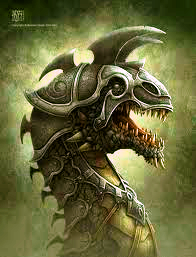War dragons (Draco siegas) were incredibly popular during the Middle Ages and were normally bred for combat. They are very powerful dragons with arrow-shaped scales. Although they were not suitable for riding, they could change the course of a battle in minutes with their enormous teeth and claws.
History[]
The first war dragons were bred during the rise of the Roman Empire. They wore the best armor the soldiers could give them and were normally quite docile, except when a code word was shouted during battle. This word was decided before the battle began, such as "Venom" or "Fang". Then the war dragon would burst from its hiding place and ravage the enemy forces.
War dragons remained in power until the eventual downfall of the Romans, after which their numbers began to rapidly decline. By the late 1800s they had almost disappeared entirely. Fortunately, the remaining specimens are under strict government protection and they are steadily increasing in population to their former numbers.

Head in war gear
Habitat[]
Most war dragons are reclusive, although fierce. They hide in various caves and alcoves all over the Middle East, rarely being seen in the light of day. Sometimes, however, they can be seen at night when they are hunting.
Appearance[]
It is hard to imagine what these beasts look like, as they have not been observed up close except for a few, unreported sightings. Most scientists agree that they are larger than the average dragon and incredibly muscular, with sharp teeth and claws. Only males have wings, while the females guard their young and never hunt.
Diet[]
Most war dragons appear to have a diet of medium to large land animals, such as deer, antelope or mountain goats that wander by their caves. They do not appear to eat humans, although it has been speculated that when the Romans bred them, they were encouraged to feed on the corpses of their enemies. However, this is only a guess, since this would be a scavenging tendency not usually found in dragons.